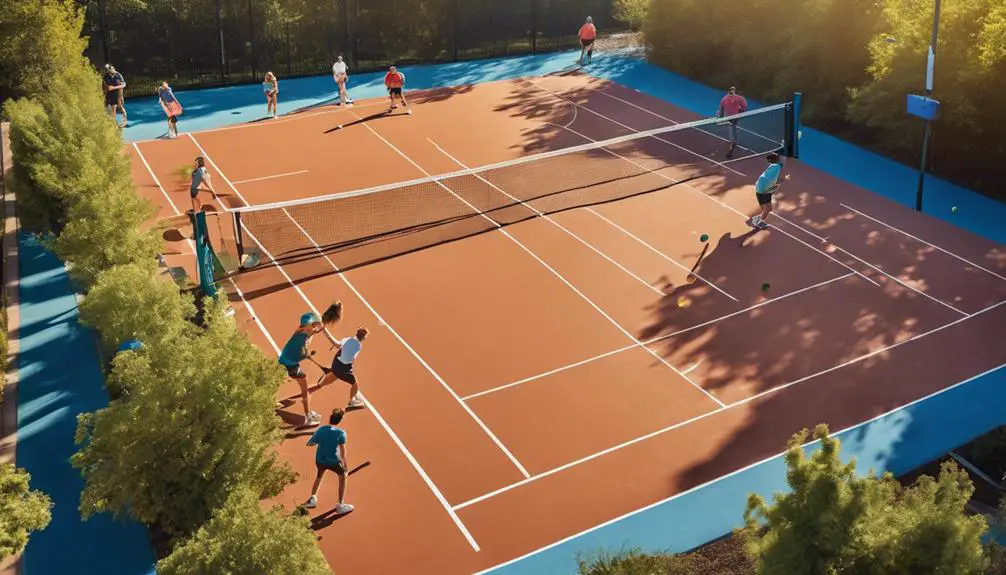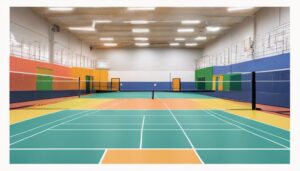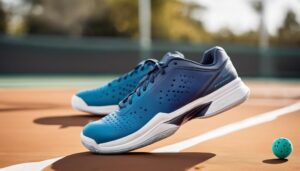Yes, you can definitely play pickleball on clay courts, and doing so brings some unique benefits. The slower ball bounce on clay enhances rallies, allowing for better strategy and stamina development. Plus, the softer surface reduces joint impact, making it gentler on your body. However, keep in mind that clay can be slippery, requiring adjustments to your footwork. Regular maintenance of the court is essential for peak play. Many players are embracing the challenges and advantages clay provides, enriching their pickleball experience. Who knows, you might find yourself enthusiastic to explore more about this growing trend.
Overview of Pickleball

Playing pickleball, a sport that has rapidly gained popularity, combines elements of tennis, badminton, and table tennis. Originating in the mid-1960s on Bainbridge Island, Washington, it was created to provide a fun family activity. Since then, pickleball has exploded in popularity, becoming a staple in community centers and parks across the U.S.
The game is played on a smaller court than tennis, measuring 20 by 44 feet. You’ll use a paddle to hit a perforated plastic ball over a net that stands at 36 inches high. One of the appealing aspects of pickleball is its accessibility; players of all ages and skill levels can join in.
Understanding the game rules is essential for an enjoyable experience. You’ll find that matches can be played as singles or doubles. Each game starts with an underhand serve, and the ball must bounce once on each side before players can engage in volleys. A unique feature is the non-volley zone—often referred to as the “kitchen”—which prevents players from smashing the ball from close range.
The simplicity of the rules and the quick learning curve make pickleball an inviting sport. Whether you’re seeking a fun way to socialize or a competitive outlet, the game’s rich history and straightforward mechanics offer a sense of freedom and excitement. Grab your paddle, and plunge into the world of pickleball—you might just find your new favorite pastime!
Characteristics of Clay Courts
Clay courts offer a unique playing surface that markedly impacts the dynamics of pickleball. Unlike hard courts, clay provides a softer feel that can affect your game in several ways. If you’re considering playing on clay, it’s vital to understand its characteristics.
- Surface Durability: Clay courts are renowned for their durability. They can withstand various weather conditions and maintain their integrity over time. However, this durability requires consistent court maintenance to guarantee the playing surface stays even and free of debris.
- Playing Dynamics: On clay, the ball tends to bounce higher and slower compared to hard surfaces. This slower pace can change your strategies, encouraging longer rallies and a more tactical style of play. You might find yourself relying more on placement and precision rather than sheer power.
- Footing and Movement: The softer surface of clay provides better traction, allowing for more controlled movements. You’ll notice that your footwork feels different, as it absorbs impact and reduces the stress on your joints. This characteristic can lead to an enjoyable experience, especially during long matches.
If you appreciate the freedom of movement and the strategic elements that come with playing on clay, you might find it invigorating. Just remember, maintaining the court is vital to preserving its unique qualities, making sure you can enjoy a consistent and engaging game every time you step on it.
Benefits of Clay for Pickleball
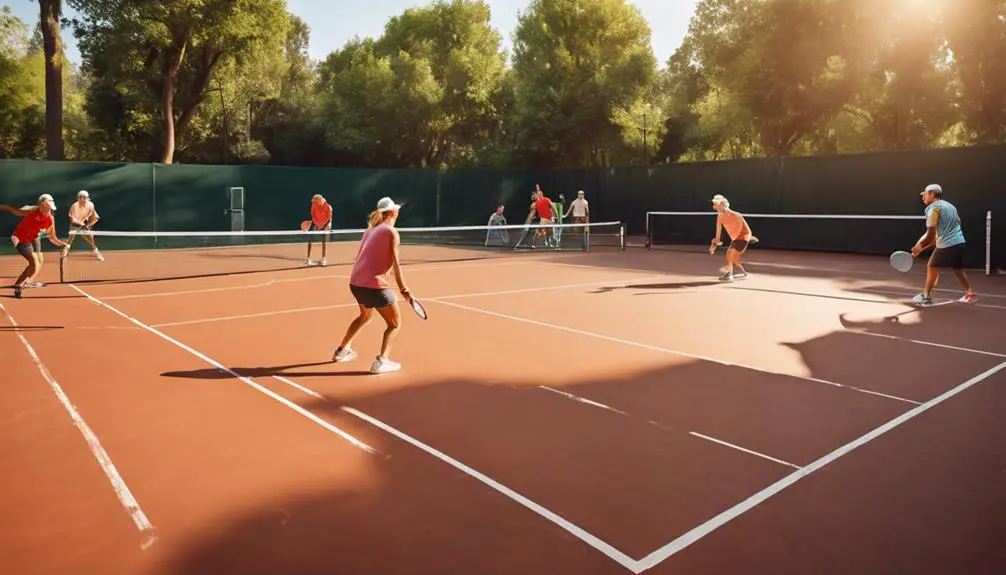
One of the standout benefits of clay courts for pickleball is their ability to enhance your overall gameplay experience. The unique surface of clay provides a slower ball bounce compared to hard courts, allowing you to develop and refine your footwork techniques. You’ll find that the extra reaction time helps you focus on positioning and strategic play, giving you a chance to anticipate your opponent’s moves.
Additionally, clay courts are generally softer, which can greatly contribute to injury prevention. The cushioning effect they provide reduces the impact on your joints, making it less taxing on your body during long matches or practice sessions. This means you can play longer and more frequently without the nagging soreness that often comes with harder surfaces.
Playing on clay also encourages you to adapt your game. You’ll need to adjust your strokes and strategies, often leading to improved overall skills. This adaptability not only makes you a more versatile player but also adds a layer of excitement to your matches.
Moreover, the slower pace on clay allows for longer rallies, which can enhance your stamina and mental focus. As you engage in lengthier exchanges, you’re likely to build a stronger sense of rhythm and timing, essential elements for mastering the nuances of pickleball.
Challenges of Playing on Clay
Steering through the unique challenges of playing on clay courts can be a learning curve for many pickleball enthusiasts. While the softer surface offers some advantages, it also introduces specific difficulties that can affect your game. Here are three key challenges you might encounter:
- Footing Issues: Clay courts can be slippery, especially right after rain or when the surface hasn’t been properly maintained. You might find yourself struggling to maintain your balance, leading to awkward movements that could result in falls or injuries. It’s crucial to adapt your footwork to navigate this tricky terrain.
- Ball Behavior: The way the ball interacts with the clay surface is different from hard courts. You’ll notice that the ball tends to bounce lower and slower, which can throw off your timing and shot selection. This altered ball behavior requires you to adjust your strategy and anticipate the ball’s movement more carefully.
- Maintenance and Consistency: Clay courts demand regular upkeep, which means the playing conditions can vary greatly from day to day. You might experience inconsistencies in how the surface plays, making it challenging to develop a reliable game plan.
Tips for Playing on Clay Courts
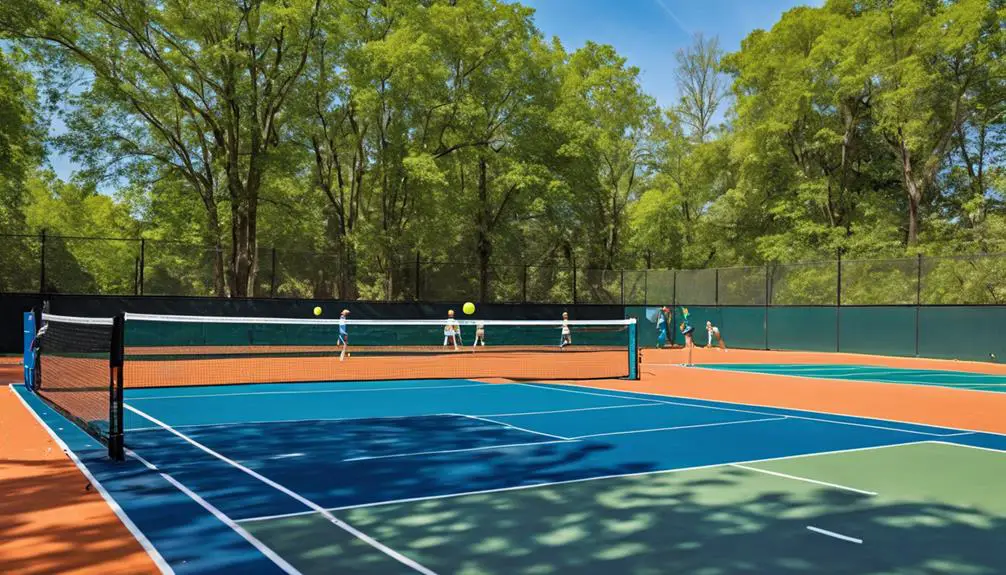
Maneuvering the intricacies of pickleball on clay courts can be rewarding with the right strategies in mind. To truly excel, you’ll want to focus on specific footwork techniques that can enhance your game. On clay, the surface can be slippery, so paying attention to your foot placement is essential. Try practicing short, quick steps to maintain your balance while moving. This way, you can effectively respond to your opponent’s shots while minimizing the risk of slipping.
Another important aspect is court maintenance, which can greatly affect your performance. Before you start playing, take a moment to assess the court’s condition. A well-maintained court should have consistent footing, so look out for any areas with excessive clay buildup or uneven surfaces. If you notice any issues, don’t hesitate to address them, as they can impact your game.
Additionally, consider adjusting your game style to the clay surface. Longer rallies might be more common, so patience and strategic shot placement become crucial. Use your footwork to position yourself effectively for each shot, allowing you to take advantage of the slower bounce typical of clay courts.
Lastly, embrace the unique rhythm that clay courts provide. The slower pace can be a great opportunity to refine your skills and develop a deeper understanding of the game. By implementing these tips, you’ll not only enhance your performance but also enjoy the freedom that comes with playing pickleball on clay courts. Happy playing!
Popularity and Growth of Clay Pickleball
The rising popularity of clay pickleball reflects a growing appreciation for the unique challenges and benefits this surface offers. As more players seek variety in their game, clay courts are becoming an enticing option. Here’s what’s driving this trend:
- Enhanced Play Experience: Clay courts provide a softer landing, reducing the risk of injuries. The slower ball speed allows for longer rallies, which can be particularly appealing to players looking to improve their skills and strategy.
- Adaptability: With clay court adaptations, you can easily adjust your pickleball equipment. Specialized shoes designed for clay can help optimize your movement and grip, ensuring you make the most of this surface. In addition, using a slightly softer paddle can enhance your play on clay, giving you the control needed for those challenging shots.
- Community Growth: As the clay pickleball community expands, more facilities are investing in clay courts. This not only promotes local tournaments but also fosters camaraderie among players. You’ll find that the social aspect of playing on clay can enhance your overall enjoyment of the game.
In essence, the growth of clay pickleball is an indication of the sport’s evolving nature. By embracing clay courts, you’re not just diversifying your playing experience; you’re also stepping into a vibrant community that celebrates the unique dynamics this surface brings to pickleball. So grab your paddle, and consider hitting the clay—it’s a game-changer!
Frequently Asked Questions
What Equipment Is Best for Playing Pickleball on Clay Courts?
For playing pickleball on clay courts, you’ll want lightweight pickleball paddles for better control and specialized court shoes with good traction to prevent slipping. This combo enhances your performance and lets you enjoy the game freely.
Are There Special Maintenance Requirements for Clay Pickleball Courts?
Maintaining clay pickleball courts is like nurturing a garden; it requires regular court preparation to guarantee surface durability. You’ll need to manage moisture levels and periodically roll the court for ideal play conditions.
Can Pickleball Be Played on Indoor Clay Courts?
Absolutely, you can play indoor pickleball on clay courts! These surfaces offer advantages like reduced impact on joints and enhanced ball control, making them ideal for players seeking a unique and enjoyable experience while staying active.
How Does Weather Affect Clay Pickleball Gameplay?
Weather can greatly affect your clay pickleball gameplay. High humidity can lead to slippery surfaces, while rain presents challenges like puddles. You’ll need to adapt your strategy to maintain control and enjoy the game effectively.
Is There a Difference in Scoring on Clay Courts?
When considering scoring rules, you’ll find they’re consistent regardless of court surface. However, the clay’s slower gameplay strategy might influence how you approach each point, allowing for more tactical rallies and longer matches. Enjoy the challenge!

